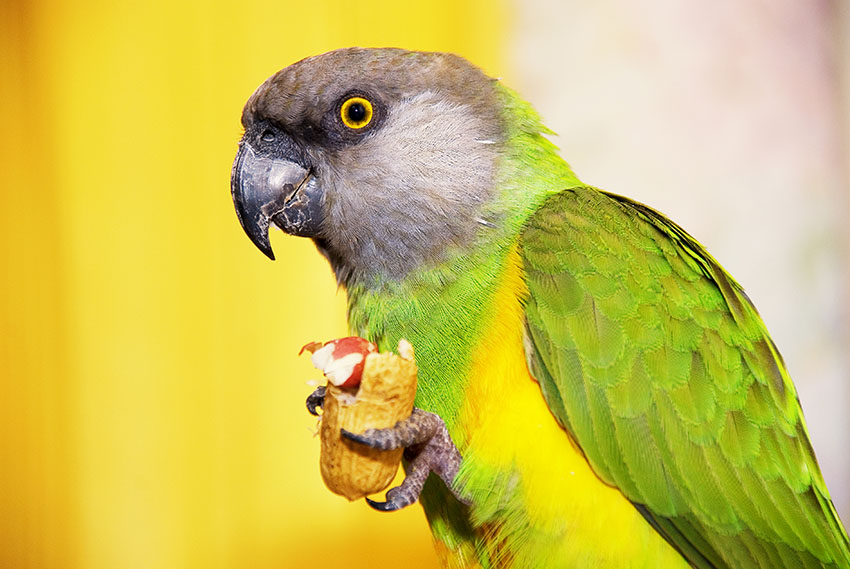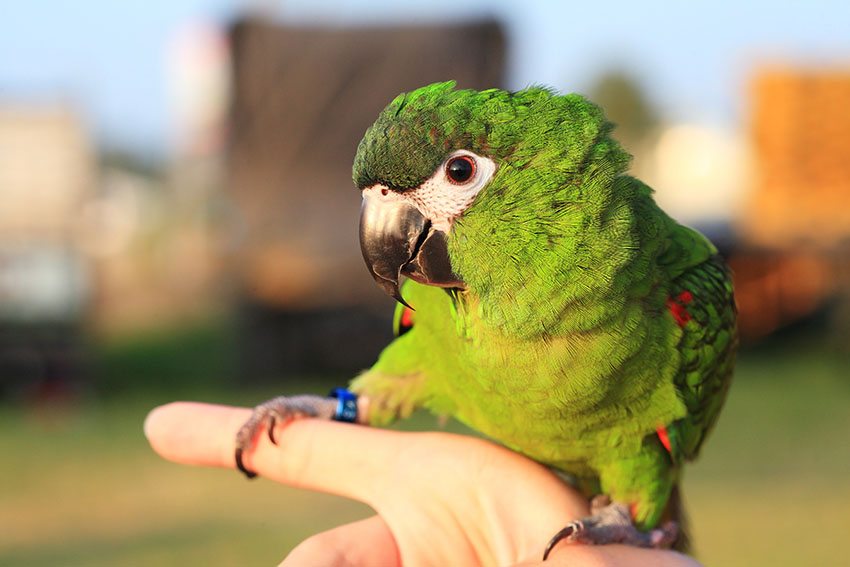- Space. The area where the training takes place should be a quiet and calm space. Any children or dogs rushing around noisily in the background will cause all but the largest and boldest parrot to become nervous, setting your efforts back several weeks. The part of the house where the bird lives is ideal, as he will have taken in all the room’s details already and is less likely to be distracted from the task in hand.
- Good mood. Training sessions will be most fruitful if your pet is relaxed and happy. If he’s just had a panic-flap around the cage, he won’t be able to instantly calm down and learn the basics of parrot/human communication! First thing in the morning is a good time. The parrot will be hungry after his night’s sleep, and this makes him more susceptible to the treat that you will be using to encourage and reinforce his learning. If you train him straight after breakfast, he’ll be less keen to earn the food rewards.
- Training tools. Gather all the things you’ll need for the session – some of the bird’s favourite treats (fruit or nuts are a good choice), a hand-held perch, and other relevant items mentioned in the points below.

Senegal Parrots - training birds requires time and patience
- Parrot-proofed room. If the bird is going to be flying around the room, make sure there are suitable perches available. Anything you don’t want him landing on or chewing can be sprayed with a shop-bought bitter apple spray, or a homemade version (2 parts apple cider vinegar to 1 part water, in a plastic spray-mister bottle).
- Familiarity. The parrot needs to get used to your hand, and then he needs to use it as a feeding perch. Once he’s settled in and calm, no longer flapping or squawking at the sight of your hand in and on the cage, offer some hand-held treats. Grip a piece of apple at the joint between your thumb and index finger, and extend your index finger as a perch. You can encourage the parrot to hop on by rubbing the finger gently just above his legs.
- Time. Keep the early sessions short. Most parrots will have had enough after 10 or 15 minutes, and you don’t want to risk making them irritable. Take it at the bird’s pace.
Parrot Training Methods
Shaping. This word is used to describe reinforcing good responses and gently discouraging unwanted ones. Many people use a clicker (of the same type used in dog training). When the parrot has done what you want him to, or made the first step towards doing it, a click and/or a treat (with an encouraging word or two thrown in) will reinforce it. This helps your bird learn a tricky manoeuvre in stages.
Target training. This helps the parrot associate a command with an action, similar to basic finger-training (mentioned in the ‘familiarity’ bullet above). Use a chopstick or length of wooden dowelling, or a similar wooden or plastic perch. Use a command phrase such as “Come on!”, and when the parrot touches the object (with beak or feet), give your clicker a click and reward the bird with a treat. In time, the object or command phrase alone will provoke the desired response – the parrot will follow it or walk/fly to it.

Red-shouldered (Hahn's) Macaw gets the hang of finger-training
Step-Up. This is a basic technique that teaches your parrot to step from one perch to another. Start off by getting him hand/finger trained (see the ‘familiarity’ bullet above), and then you can move it up a gear. Grip your clicker in one hand, and offer the perch you want the parrot to step onto. It’s a natural instinct, so most birds will step up without much prompting. But if you say “Step up!” as he does so, the words will, over time, become a prompt.
Once again, click the clicker to reinforce the good behaviour. As you progress, move the two perches further and further apart, until the parrot has to walk a long way (or fly) in order to get to the second position. If he proves reluctant, employ the gradual ‘shaping’ method mentioned above, to help him learn in stages (e.g. in this instance, if the bird taps the second perch with his beak, that counts as a step in the right direction and should be rewarded).
If all this has gone well, you now have a bird who is relaxed in your company, happily uses you as a perch, and will ‘step up’ from one place to another at your prompting.
Comments
Barb, 4 February 2019
We got our Macau very young and hand fed him. Still having problems with biting. I can use some suggestions on that issue! I taught him a few games which he learned easily. His favorite is cops and robbers. He puts both wings fully up after searching for treat to steal. Stick em Up. Also rides bicycle. Need help to stop biting? He also talks but only when he feels like it.